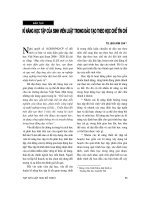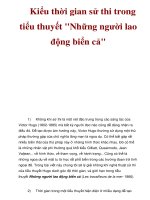MELALEUCA FOREST HABITAT IN TRA SU MELALEUCA FOREST LANDSCAPE CONSERVATION AREA, TINH BIEN DISTRICT,AN GIANG PROVINCE TRAN THI KIM HONG và NHỮNG NGƯỜI KHÁC, tạp CHÍ đại học THỦ dầu một, số 1(40),2019,TR 60 69
Bạn đang xem bản rút gọn của tài liệu. Xem và tải ngay bản đầy đủ của tài liệu tại đây (1.09 MB, 10 trang )
������������������������������������������������������������������������������������������������������������������������������������������������������������������������������������������������������������������������������������������������������������������������������������������������������������������������������������������������������������������������������������������������������������������������������������������������������������������������������������������������������������������������������������������������������������������������������������������������������������������������������������������������������������������������������������������������������������������������������������������������������������������������������������������������������������������������������������������������������������������������������������������������������������������������������������������������������������������������������������������������������������������������������������������������������������������������������������������������������������������������������������������������������������������������������������������������������������������������������������������������������������������������������������������������������������������������������������������������������������������������������������������������������������������������������������������������������������������������������������������������������������������������������������������������������������������������������������������������������������������������������������������������������������������������������������������������������������������������������������������������������������������������������������������������������������������������������������������������������������������������������������������������������������������������������������������������������������������������������������������������������������������������������������������������������������������������������������������������������������������������������������������������������������������������������������������������������������������������������������������������������������������������������������������������������������������������������������������������������������������������������������������������������������������������������������������������������������������������������������������������������������������������������������������������������������������������������������������������������������������������������������������������������������������������������������������������������������������������������������������������������������������������������������������������������������������������������������������������������������������������������������������������������������������������������������������������������������������������������������������������������������������������������������������������������������������������������������������������������������������������������������������������������������������������������������������������������������������������������������������������������������������������������������������������������������������������������������������������������������������������������������������������������������������������������������������������������������������������������������������������������������������������������������������������������������������������������������������������������������������������������������������������������������������������������������������������������������������������������������������������������������������������������������������������������������������������������������������������������������������������������������������������������������������������������������������������������������������������������������������������������������������������������������������������������������������������������������������������������������������������������������������������������������������������������������������������������������������������������������������������������������������������������������������������������������������������������������������������������������������������������������������������������������������������������������������������������������������������������������������������������������������������������������������������������������������������������������������������������������������������������������������������������������������������������������������������������������������������������������������������������������������������������������������������������������������������������������������������������������������������������������������������������������������������������������������������������������������������������������������������������������������������������������������������������������������������������������������������������������������������������������������������������������������������������������������������������������������������������������������������������������������������������������������������������������������������������������������������������������������������������������������������������������������������������������������������������������������������������������������������������������������������������������������������������������������������������������������������������������������������������������������������������������������������������������������������������������������������������������������������������������������������������������������������������������������������������������������������������������������������������������������������������������������������������������������������������������������������������������������������������������������������������������������������������������������������������������������������������������������������������������������������������������������������������������������������������������������������������������������������������������������������������������������������������������������������������������������������������������������������������������������������������������������������������������������������������������������������������������������������������������������������������������������������������������������������������������������������������������������������������������������������������������������������������������������������������������������������������������������������������������������������������������������������������������������������������������������������������������������������������������������������������������������������������������������������������������������������������������������������������������������������������������������������������������������������������������������������������������������������������������������������������������������������������������������������������������������������������������������������������������������������������������������������������������������������������������������������������������������������������������������������������������������������������������������������������������������������������������������������������������������������������������������������������������������������������������������������������������������������������������������������������������������������������������������������������������������������������������������������������������������������������������������������������������������������������������������������������������������������������������������������������������������������������������������������������������������������������������������������������������������������������������������������������������������������������������������������������������������������������������������������������������������������������������������������������������������������������������������������������������������������������������������������������������������������������������������������������������������������������������������������������������������������������������������������������������������������������������������������������������������������������������������������������������������������������������������������������������������������������������������������������������������������������������������������������������������������������������������������������������������������������������������������������������������������������������������������������������������������������������������������������������������������������������������������������������������������������������������������������������������������������������������������������������������������������������������������������������������������������������������������������������������������������������������������������������������������������������������������������������������������������������������������������������������������������������������������������������������������������������������������������������������������������������������������������������������������������������������������������������������������������������������������������������������������������������������������������������������������������������������������������������������������������������������������������������������������������������������������������������������������������������������������������������������������������������������������������������������������������������������������������������������������������������������������������������������������������������������������������������������������������������������������������������������������������������������������������������������������������������������������������������������������������������������������������������������������������������������������������������������������������������������������������������������������������������������������������������������������������������������������������������������������������������������������������������������������������������������������������������������������������������������������������������������������������������������������������������������������������������������������������������������������������������������������������������������������������������������������������������������������������������������������������������������������������������������������������������������������������������������������������������������������������������������������������������������������������������������������������������������������������������������������������������������������������������������������������������������������������������������������������������������������������������������������������������������������������������������������������������������������������������������������������������������������������������������������������������������������������������������������������������������������������������������������������������������������������������������������������������������������������������������������������������������������������������������������������������������������������������������������������������������������������������������������������������������������������������������������������������������������������������������������������������������������������������������������������������������������������������������������������������������������������������������������������������������������������������������������������������������������������������������������������������������������������������������������������������������������������������������������������������������������������������������������������������������������������������������������������������������������������������������������������������������������������������������������������������������������������������������������������������������������������������������������������������������������������������������������������������������������������������������������������������������������������������������������������������������������������������������������������������������������������������������������������������������������������������������������������������������������������������������������ and NN256 (lot 5b) as heavy clay so when
the older the trees grow and the roots develop to this layer, the development of Melaleuca will be
significantly affected (Truong Thi Nga et al., 2009).
65
Trần Thị Kim Hồng...
Melaleuca forest habitat in tra su melaleuca forest...
- Density of dead trees in cells NN157 and ST164 is quite high, dead density in cells NN157
is 7,033 trees/ha and in cell ST164 is 12,100 trees/ha.
10 - 15 years
> 30 years
16 - 20 years
21 - 25 years
26 - 30 years
Figure 6. Melaleuca diameter in age group
Status of habitat of Tra Su Melaleuca forest landscape conservation area
Melaleuca forest at Tra Su Melaleuca forest landscape conservation area are stratified by
height. The layers are closely related to each other including the composition of trees, the composition
of shrubs under Melaleuca canopy, the composition of fresh vegetation and exotic vegetation.
However, the habitat of Melaleuca forests, lotus and Eleocharis is very flooded in rainy season (> 1
meter flood), but drought occurs in dry season and forest fire warning at level 5. Therefore, there are
only some plants existing in Melaleuca habitat and the diversity of this habitat is not high.
Composition of trees
The composition of timber in Tra Su Melaleuca forest is mainly Melaleuca cajuputi with
relatively thick density (4,673 trees/ha) and many different ages. In addition to Melaleuca, there are also
Acacia mangium, Eucalyptus alba, Acaciaauriculaeformis, etc. They grow mainly on the forest edges.
Figure 7. Compositions of timber
66
Thu Dau Mot University Journal of Science
Issue 1(40)-2019
Compositions of shrubs under Melaleuca canopy
The compositions of main shrubs are found in the forest edge habitat. In addition, some
varieties are found in forest habitat and lotus habitats such as Sesbania sesban, Mimosa pigra,
Phragmites australis, etc. They grow right under the forest canopy with low and scattered densities,
growing in small clusters.
The composition of shrubs contributes to the diversity of habitat in the forest, which is home
to many species of animals and insects such as ants, birds, worms, etc. However, the strong
development of shrubs also leads to bad influences, causing loss of paths in the forest canopy.
Thriving shrubs will use more organic matters in the soil, affecting the growth and development of
Melaleuca forest.
Composition of fresh vegetation
Fresh vegetation in the forest includes herbaceous plants (without wood structure), mainly
distributed in forest edge habitats. In addition, some plants are found in:
- Forest habitat and lotus habitat: Brachiara mutica, Eclipta prostrata, Cyclosorus
parasiticus, Glinus oppositifolius.
- Melaleuca forest habitat: Scoparia dulcis, Ceratopteris thalictroides, Axonopus compressus,
Struchium sparganophorum, Ageratum conyzoides, Alternanthera sessilis, Ludwigia adscendens,
Heliotropium indicum.
- Lotus habitat: Acalypha brachystachya, Panicum repens, Commelina paludaso, Euphorbia
atoto, Cyperus digitatus
- Eleocharis habitat: Eleocharis dulcis
Figure 8. Some plants of fresh vegetation
The role of fresh vegetation as well as shrubs, many plants bring highly economic benefits.
From an ecological point of view, layers of shrubs and fresh vegetation are important, and they
contribute to soil protection, erosion prevention, soil moisture retention, and soil formation and
improvement. However, they may also be obstacles to regeneration, which causes difficulties in
reforestation and rehabilitation.
Exotic plants
The major exotic plants are vines found in the forest edge habitat. In addition, some plants are
found in:
67
Trần Thị Kim Hồng...
Melaleuca forest habitat in tra su melaleuca forest...
- Forest landscape habitat and lotus habitat: Lygodium japonicum, Pueraria phaseoloides,
Stenochiaena palustris, Zehneria indica, Passiflora foetida, Ipomoea aqiuatica.
- Melaleuca forest habitat: Lygodium japonicum, Cayratia trifolia.
Figure 9. Exotic plants
Vine plants contribute to the increase in biodiversity in the forest, and they are also home to
insects such as ants, insects, etc. Excessive exotic vegetation affects the growth and development
process of Melaleuca forest: their supporters are Melaleuca stems. The vines living on to
Melaleuca’s stem will damage the Melaleuca, they absorb nutrients from the Melaleuca and make
them develop slowly, etc.
In addition, in the lotus habitat and some Melaleuca of permanent flood, such as ST164 (slot
4a), there is also the presence of aquatic plants such as Lemnoideae, Pistia stratiotes.
CONCLUSION AND RECOMMENDATION
Conclusion
Melaleuca is in Tra Su Melaleuca forest conservation area is quite large, mainly over 20
years, the density of Melaleuca is very thick to very thick: from 3,000 trees/ha with Melaleuca in
age group from 21 to 25 years to age group from 26 - 30 years, 10 - 15 years and 16 - 20 years are
4,550 trees/ha, 4,900 trees/ha and 5,083 trees/ha, respectively, with the highest number of trees in
the age group of 30 years with 5,833 trees/ha.
The average height is lowest in the 26 - 30 age group with the height of 13.11 m, the highest
average height group is the age group 10 - 15 years with the height of 18.01 m.
The highest average diameter in the 21 - 25 age group is 18.93 cm and the lowest is the 26 30 age group at 17.75 cm.
The criteria of height, diameter at chest height, the density show that the growth and
development of Melaleuca in Tra Su forest depend not only entirely on the age of Melaleuca forest
68
Thu Dau Mot University Journal of Science
Issue 1(40)-2019
but also depends on factors such as flooding, soil, shrubs and vines, etc Degraded forest area is the
survey cells NN25, NN239 and ST164 respectively of cells 5b, 2b, 4a. It should be planted in
degraded and dead areas.
Melaleuca forest is stratified at the height, including the composition of timber, the
composition of shrubs under Melaleuca canopy, the composition of fresh vegetation and exotic
plants, but the effect is negligible.
Recommendation
Further research on (fresh and dry) biomass and carbon reserves of Melaleuca forest,
subterranean elements and organic layer of Melaleuca should be continued to be done.
It is necessary to consider and study solutions to overcome the overcrowding of Melaleuca
forest, to grow trees on bare land and in dead Melaleuca forest.
REFERENCES
An Giang’s Forest Protection Department (2004). Luận chứng khoa học thành lập Khu Bảo vệ cảnh
quan Trà Sư, tỉnh An Giang.
Lâm Bỉnh Lợi, Nguyễn Văn Thôn (1972). Rừng ngập nước Việt Nam. Bộ Nông nghiệp và Ngư
nghiệp Sài Gòn.
Lê Minh Lộc (2005). Phương pháp đánh giá nhanh sinh khối và ảnh hưởng của độ sâu ngập lên
sinh khối rừng Tràm (Melaleuca cajuputi) trên nền đất than bùn và đất phèn khu vực U Minh
Hạ tỉnh Cà Mau (Luận văn Thạc sĩ). Đại học Can Tho.
Lê Quốc Tuấn, Nguyễn Thị Hà Vy, Bùi Xuân An (xxxx). Nghiên cứu và định hướng phát triển du
lịch sinh thái rừng tràm Trà Sư, tỉnh An Giang. Retrieved />data/quoctuan/Bai%20bao%203%20_Khoa%20MT-TN_.pdf, dated Dec 23rd 2017.
Ministry of Forest (1984). Quy phạm thiết kế kinh doanh rừng . Quyết định 682/QĐKT.
Phạm Xuân Quý (2008). Xây dựng mô hình dự đoán sinh khối rừng tràm (Melaleuca cajuputi) ở
khu vực Tây Nam Bộ. Retrieved
/>download&gid=453&Itemid=498&lang=v, dated Dec 23rd 2017.
Trương Thị Nga, Đinh Hoài Ửng, Nguyễn Công Thuận (2009). Hiện trạng đất khu bảo vệ cảnh
quan rừng tràm Trà Sư - tỉnh An Giang. Can Tho University Journal of Science (12), 9–14.
69









